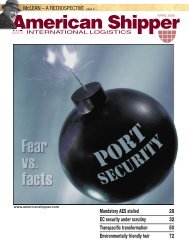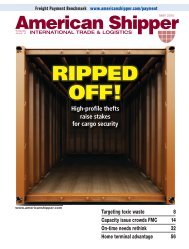Pirate Busters - American Shipper
Pirate Busters - American Shipper
Pirate Busters - American Shipper
Create successful ePaper yourself
Turn your PDF publications into a flip-book with our unique Google optimized e-Paper software.
<strong>Shipper</strong>s, barge operators seek<br />
inland waterways modernization.<br />
BY CHRIS GILLIS<br />
When Michael Hennessey, vice president of river<br />
operations for CONSOL Energy, looks across<br />
the Monogehela River he’s witness to the daily<br />
flow of barges full of coal coming from the company’s western<br />
Pennsylvania mines.<br />
These towed coal barges, along with those of CONSOL’s<br />
competitors, float by Hennessey’s office window in Monessen,<br />
Pa., through a lock-and-dam system on the Monogehela.<br />
The river is a vital commercial artery to<br />
the heart of the U.S. inland waterways<br />
system — the Mississippi River — which<br />
ultimately pours into the Gulf of Mexico.<br />
But Hennessey isn’t fooled by the river’s<br />
apparent placidity. He knows danger lurks<br />
in the Monogehela. A catastrophic breakdown<br />
of one of the river’s aging locks,<br />
namely the 100-year-old Lock 3, would<br />
bring hundreds of thousands of tons of<br />
barge traffic to an abrupt halt with little<br />
opportunity to quickly or efficiently divert<br />
the cargo to other land-based transport<br />
modes.<br />
“Lock 3 is about ready to fall into the<br />
river,” Hennessey said. “If that happens, it<br />
would stop the barge traffic on the river.”<br />
40 AMERICAN SHIPPER: OCTOBER 2009<br />
The lock’s failure would not only wreak<br />
economic havoc on nearby towns and mining<br />
operations that depend on the river for<br />
their vitality, but could send shockwaves<br />
through the national economy. The Army<br />
Corps of Engineers’ efforts to repair a<br />
failed lock on the Monogehela under this<br />
scenario would take months, if not longer,<br />
to complete. “It would be a catastrophe,”<br />
Hennessey said.<br />
<strong>Shipper</strong>s and barge operators on the<br />
Monogehela are not alone. There are numerous<br />
other locks and dams throughout<br />
the nation’s 12,000-mile inland waterways<br />
system that need modernizing. The average<br />
age of the 192 lock sites is more than<br />
50 years old.<br />
“It’s a ticking time bomb,” said Leon<br />
Crites, manager of marine transportation<br />
and logistics for Houston-based CITGO<br />
Petroleum Corp. “A major shutdown would<br />
raise the cost of doing business and the<br />
<strong>American</strong> taxpayer would end up paying<br />
for it.”<br />
Only Option. The main purpose for these<br />
locks and dams is to raise and lower water<br />
levels and provide safe transport channels<br />
on rivers, such as the Ohio, Illinois, Tennessee<br />
and Upper Mississippi, and numerous<br />
tributaries to the Mississippi River basin.<br />
Many of the first and second-generation<br />
locks and dams were built in the 1930s<br />
and 1950s. For example, locks and dams<br />
20 to 25 on the Mississippi River along<br />
Missouri’s Northeast border were erected<br />
between 1932 and 1936, while on the Illinois<br />
waterway, the Lagrange and Peoria locks<br />
and dams were both completed in 1936.<br />
The Army Corps of Engineers, manager<br />
and caretaker of the inland waterways system,<br />
estimates that more than 625 million<br />
tons, valued at $70 billion, of liquid and<br />
bulk commodities, including grains, coal,<br />
metals, cement, sand and gravel, chemicals<br />
and petroleum, pass through the inland<br />
waterway system each year. More than half<br />
of the country’s grain and oilseed exports<br />
rely on the river system for transport to<br />
ports for loading onto deep-sea vessels.










